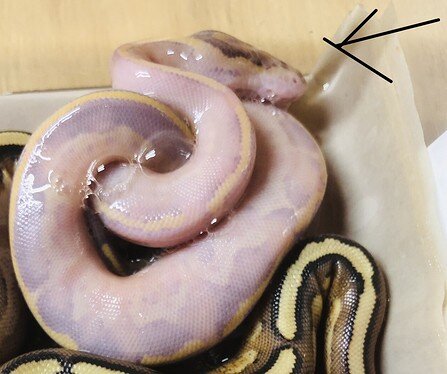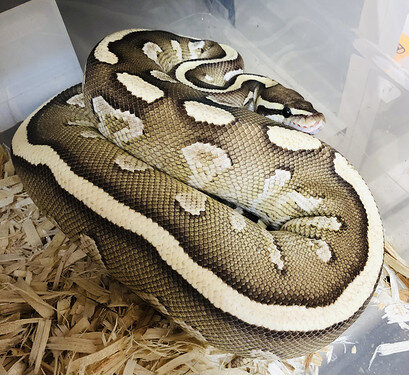I agree here. In my experience one eye/no eyes is almost always an incubation issue, I would guess temp spikes or high temps being the issue. In the US we are pairing snakes coming from different collections across the nation, each with different origins. In the wild ball pythons may hatch, not travel far at all, and end up reproducing with other snakes in the same geographical location. Additionally, most people who do pair genetically related snakes often have no issues, or definable issues. Snakes in general have DNA that tends to be resistant to inbreeding, even with parthenogenetic offspring being produced regularly and thriving. These animals are in essence clones and often have no such defects. I have also bred snakes one year, had a cramped egg tub, resulted in one/no eyes, repeated the pairing with lower incubation temps and had perfect success for years following.
About the question of messing with the eggs it must be remembered that the python mother shivers, tighten and loose her coil for thermoregulation the clutch. If events like opening the incubator to pick at the eggs for a few seconds every day was the reason for the deformities in baby ball pythons the species would be doomed in the wild.
My interpretation is that most of these defects are genetic even if the trigger was thermal shock.
I only know of burmese pythons doing this, I’ve heard of retics and diamond pythons as well but someone else will have to chime in. That said, ball pythons are not one of the species that exhibit this behavior, and even in Burms they are shivering gently around a pile of stationary eggs stuck tightly to each other. The mother is trying to achieve consistency in an imperfect environment.
Messing with eggs constitutes a large shift in position or rotation of the egg. Like picking it up and removing it from the box to look at/candle etc. Temperature changes are the biggest factor as opening the incubator leads to a cold spike, your heater powers on and you overshoot your target, back and forth until the incubator regains homeostasis. These types of changes are likely to result in issues and do not reflect natural behavior. Additionally, a large clutch in a tight egg box, especially as it nears hatching will generate a significant amount of heat which can be an issue.
Another reason I don’t believe this deformity is genetic is it presents itself commonly and always with the same outward appearance, but across many different morphs and origins. We would also suspect a genetic deformity to reproduce itself according to other genetic patterns in the species, and so far no one has proven to have a line of “het no eyes” “super no eyes” etc that repeats itself.
Last year I produced a one eyed snake that resulted from a captive hatched normal female and a completely unrelated citrus pastel male. They had produced multiple perfect clutches through the years prior and the rest of this clutch was fine as well, the egg tub however was more crowded than I would prefer and generating noticeable heat towards the end of incubation, that’s what I would suspect caused the deformity.
I’ve seen really closed incubators kill hundreds of babies because of overcrowding and CO2 buildup. At a point, eggs begin producing heat during incubation.
My female sugar YB Spider respectively has no eyes, yet has produced clutches of the following:
2016: 6 fertile no issues.
2017: 6 fertile 1 slug no issues.
2018 8 fertile no issues.
2019 9 fertile no issues.
2020 8 fertile no issues.
2021 due any day.
I don’t believe the eyeless issues is genetic. As mentioned, it’s happened randomly among various morphs, even those clutches that have been completely unrelated.
This is the kind of information we need when we bring forward topics like this.

By breeding snakes with issues related to non optimal hatchery practices at the same time that otherwise the incubation happens in an absurd stable environment we are selecting the group to be very sensitive to the incubation parameters; having perfect health babies until something goes wrong and the babies are born with deformities rather than just weak.
So hatched two of these, this is a male leopard Ivory possibly Enchi. So I’m thinking I’m going to keep them for now. Friends of mine suggest breeding the parents one more time to see if it was conditional or genetic.
I haven’t decided yet.
Why even take the chance? Pair them with something else. Me personally I’m not breeding or selling any snakes with visual defects such as missing eyes or kinks. I see zero upside in it at all.
I know how you feel coming from one of the biggest Caramel Albino fans. I sold all Caramel related projects for the simple fact of kinks and infertility.
I’m extremely interested in breeding my Mojave Fire Yellowbelly to the superstripe anyways but it’s always good to talk about whats happening.
Here he is…
Very pretty 
Why take the chance? Because that’s how science works, that’s how we learn as a whole even if some casualties may occur. This happens to humans, it happens with anything, loss happens. Also because it is more likely to have no issues at all if he follows proper incubation protocols.
Nature has selected for these traits for thousands of years, ball pythons are ball pythons for every minute reason that has evolved along the way, including the fact that ball pythons hatch optimally with consistent and defined conditions. Humans have “selected” for mostly a few colors and patterns that represent a couple generations, or a microscopic blip in the time of this species’ development. The process that selected for ball pythons’ incubation requirements has been in the works for much much longer and doesn’t seem to be currently influenced by man.
No? As an actual scientist, if my research mice were ever born without eyes the facility veterinarian would be all over us to euthanise not only the offspring but both parents.
We have very high standards for ethical treatment of animals
I’m breeding healthy snakes not conducting scientific experiments.
If it were proven to be a genetically heritable defect. If it was proven your environment caused the defect, you would euthanize those that are suffering, but to truly fix the issue you would change the faulty environment, not stop breeding mice forever.
And I’m doing both!
I didn’t realize you were a scientist.
Being a scientist isn’t all about your occupation. I do have a bachelor’s in Biology and spent plenty of time in labs, these days I focus on my animals. The scientific method is a key approach to learning and making advancements to become a better caretaker and achieve greater understanding of these animals that mean so much to me. I think we all ought to exercise good science.


